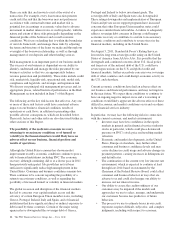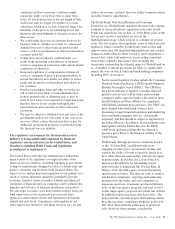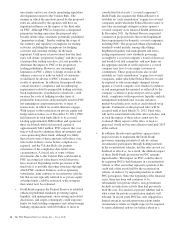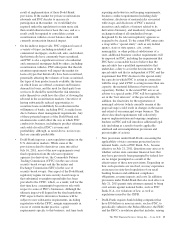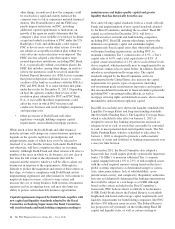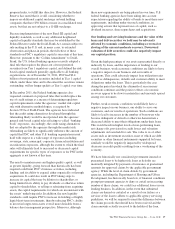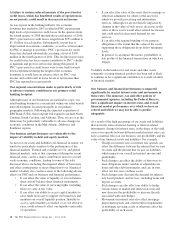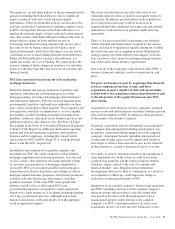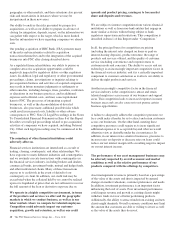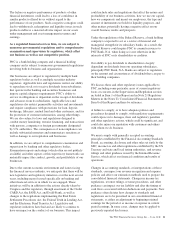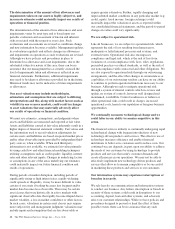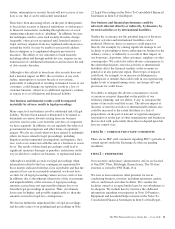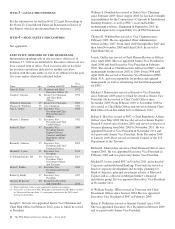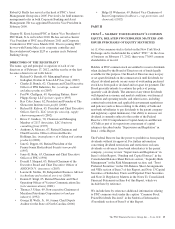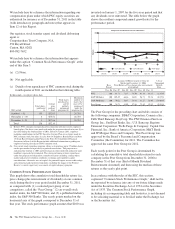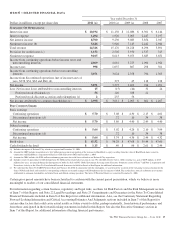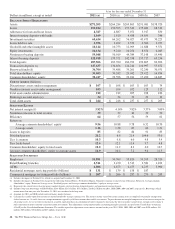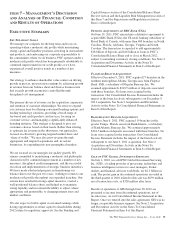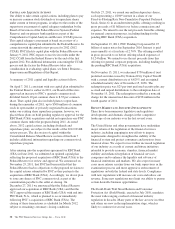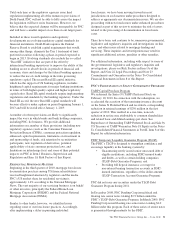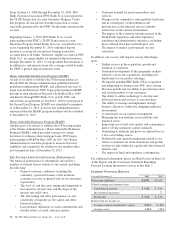PNC Bank 2011 Annual Report Download - page 31
Download and view the complete annual report
Please find page 31 of the 2011 PNC Bank annual report below. You can navigate through the pages in the report by either clicking on the pages listed below, or by using the keyword search tool below to find specific information within the annual report.The determination of the amount of loss allowances and
impairments taken on our assets is highly subjective, and
inaccurate estimates could materially impact our results of
operations or financial position.
The determination of the amount of loss allowances and asset
impairments varies by asset type and is based upon our
periodic evaluation and assessment of known and inherent
risks associated with the respective asset class. Such
evaluations and assessments are revised as conditions change
and new information becomes available. Management updates
its evaluations regularly and reflects changes in allowances
and impairments in operations as such evaluations are revised.
Although we have policies and procedures in place to
determine loss allowance and asset impairments, due to the
substantial subjective nature of this area, there can be no
assurance that our management has accurately assessed the
level of impairments taken and allowances reflected in our
financial statements. Furthermore, additional impairments
may need to be taken or allowances provided for in the future.
Historical trends may not be indicative of future impairments
or allowances.
Our asset valuation may include methodologies,
estimations and assumptions that are subject to differing
interpretations and this, along with market factors such as
volatility in one or more markets, could result in changes
to asset valuations that may materially adversely affect
our results of operations or financial condition.
We must use estimates, assumptions, and judgments when
assets and liabilities are measured and reported at fair value.
Assets and liabilities carried at fair value inherently result in a
higher degree of financial statement volatility. Fair values and
the information used to record valuation adjustments for
certain assets and liabilities are based on quoted market prices
and/or other observable inputs provided by independent third-
party sources, when available. When such third-party
information is not available, we estimate fair value primarily
by using cash flow and other financial modeling techniques
utilizing assumptions such as credit quality, liquidity, interest
rates and other relevant inputs. Changes in underlying factors
or assumptions in any of the areas underlying our estimates
could materially impact our future financial condition and
results of operations.
During periods of market disruption, including periods of
significantly rising or high interest rates, rapidly widening
credit spreads or illiquidity, it may be more difficult to value
certain of our assets if trading becomes less frequent and/or
market data becomes less observable. There may be certain
asset classes that were historically in active markets with
significant observable data that rapidly become illiquid due to
market volatility, a loss in market confidence or other factors.
In such cases, valuations in certain asset classes may require
more subjectivity and management judgment; valuations may
include inputs and assumptions that are less observable or
require greater estimation. Further, rapidly changing and
unprecedented market conditions in any particular market (e.g.
credit, equity, fixed income, foreign exchange) could
materially impact the valuation of assets as reported within
our consolidated financial statements, and the period-to-period
changes in value could vary significantly.
We are subject to operational risk.
Like all businesses, we are subject to operational risk, which
represents the risk of loss resulting from human error,
inadequate or failed internal processes and systems, and
external events. Operational risk also encompasses
compliance and legal risk, which is the risk of loss from
violations of, or noncompliance with, laws, rules, regulations,
prescribed practices or ethical standards, as well as the risk of
our noncompliance with contractual and other obligations. We
are also exposed to operational risk through our outsourcing
arrangements, and the effect that changes in circumstances or
capabilities of our outsourcing vendors can have on our ability
to continue to perform operational functions necessary to our
business. Although we seek to mitigate operational risk
through a system of internal controls which we review and
update, no system of controls, however well designed and
maintained, is infallible. Control weaknesses or failures or
other operational risks could result in charges, increased
operational costs, harm to our reputation or foregone business
opportunities.
We continually encounter technological change and we
could falter in our ability to remain competitive in this
arena.
The financial services industry is continually undergoing rapid
technological change with frequent introductions of new
technology-driven products and services. The effective use of
technology increases efficiency and enables financial
institutions to better serve customers and to reduce costs. Our
continued success depends, in part, upon our ability to address
the needs of our customers by using technology to provide
products and services that satisfy customer demands and
create efficiencies in our operations. We may not be able to
effectively implement new technology-driven products and
services that allow us to remain competitive or be successful
in marketing these products and services to our customers.
Our information systems may experience interruptions or
breaches in security.
We rely heavily on communications and information systems
to conduct our business. Any failure, interruption or breach in
security of these systems could result in disruptions to our
accounting, deposit, loan and other systems, and adversely
affect our customer relationships. While we have policies and
procedures designed to prevent or limit the effect of these
possible events, there can be no assurance that any such
22 The PNC Financial Services Group, Inc. – Form 10-K


